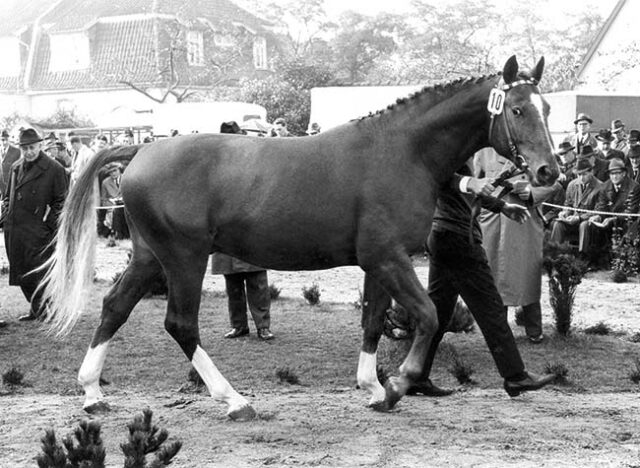
By Ludwig Christmann
Photography: Hannoveraner Verband
The Dutch breeding of sport horses has become one of the most successful breeding programs worldwide for all three Olympic disciplines. The breeding area is located in the adjoining German neighbourhoods of both Hannover and the Rhineland. Hence KWPN stallions also attract the interest of breeders of the Hannoveraner Verband.
There is a lot of interest in Dutch genetics, especially with respect to dressage horses. So there are good reasons to take a closer look at KWPN dressage horse breeding.
What is the origin of the breed?
The Netherlands was home to two Warmblood breeds. The Groninger was bred in the north and was similar to the Altoldenburger and the Ostfriesen. The Gelderlander was bred in the south, its build is lighter. It was originally used as a workhorse for agriculture and as a cart horse. After World War II, as mechanization in society and agriculture gained momentum and equestrian sports increased in popularity, these horses were also used under saddle. “The Gelderlander was a real all-rounder; for work in the countryside, at the weekend for riding in dressage, jumping or eventing, and on Sundays as a means to get to church. Its characteristics were just as versatile: a strong horse with a good walk and trot with a lot of flexion in the joints and a sublime front-leg technique with a lot of shoulder freedom and knee action. At the time, the selection process for character and willingness to perform already existed: People parted with horses that did not want to work,” said Johan Hamminga, a dressage trainer up to the Grand Prix-level and a member of the KWPN licensing commission, in his description of the Gelderlander.
According to literature (Wikipedia), the Andalusian, Neapolitan, and Anglo-Norman breeds, as well as Norfolk Trotters, are mentioned as breeds that influenced the Gelderlander. In fact, the latter, of English origin, influenced various trotter breeds.
Changing the breeding process towards creating riding horses began as early as the 1950s with imported stallions such as the Anglo-Norman L‘Invasion or the Holstein Normann and later Amor, to name a few. But also the Hannoveraner Eclatant by Duellant x Ableger II out of the mare line of Nehrung (breeder: Claus Schmoldt, Hollerdeich) played a role. This stallion, born in 1963, sold to the Netherlands at Verden’s stallion sales in 1965. In the 06/1965 issue of Hannoversches Pferd, he is described as a “strong stallion with a very steadfast character, a short cannon-bone and very good, swinging movements”.
In 1969, the existing studbooks merged and the Royal Warmblood Studbook of the Netherlands (KWPN) was founded. Since 2006, there have been four official breeding directions: The dressage horse, the showjumping horse, the carriage horse, and the Gelder horse. Foreign genetics were heavily used in the development of the dressage and show-jumping breeding lines: Trakehner stallions such as Doruto (born 1962 by Komet) and Gribaldi (born 1993 by Kostolany), Holsteiner stallions such as Flemmingh (born 1987 by Lacapo), Selle Français stallions such as Le Mexico (born 1970 by Mexico, a right-hand brother of Furioso II), but also Hannoveraner stallions were used. In particular, Voltaire by Furioso II x Gotthard (born in 1979; bred by Erika Kuwert, Mülheim), had a strong, positive influence on the development of the breeding of Dutch showjumpers. Lord Leatherdale by Lord Loxley x Ferragamo, born in 2003 and bred in the Rhineland by Zuchtgemeinschaft Pleines in Uedem, continues to be popular in the breeding of dressage horses. Among others, he is the sire of Glamourdale, the world champion of young dressage horses 2019.
The breeding principles
In the book The KWPN Horse, published by the KWPN in 2012, the breeding objectives and selection characteristics of the Dutch dressage horse are described in detail. The breeding goal is explicitly defined as striving to produce a horse that has the conformation and movement to be successful in Grand Prix. Many criteria are similar to those in Hannover, but some accents are definitely set differently. “Raising the forehand is one of the basics of dressage and that is why we prefer an upright (vertical) neck carriage in the dressage horse,” as formulated in The KWPN Horse. Great importance is also attached to the horses being constructed uphill and, above all, to them moving uphill, bringing the forehand up in the movement, having good self-carriage, and being light-footed. For this they should be supple in the joints with an active hind leg and a bit of knee action... To read the complete article you need to be a subscriber
CLICK HERE TO SUBSCRIBE TO BREEDING NEWS
SUBSCRIBERS CAN READ THE COMPLETE ARTICLE BY LOGGING IN AND RETURNING TO THIS PAGE




